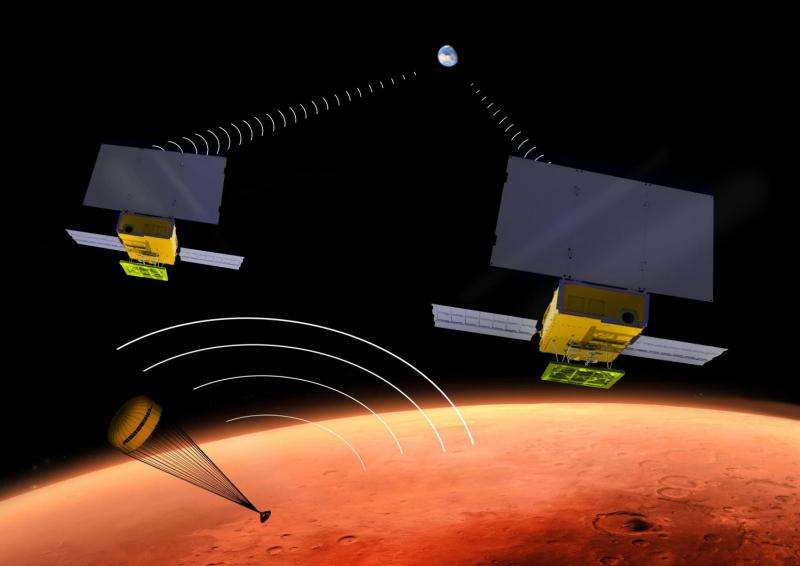November 3, 2015 report
CubeSats in deep space

(Phys.org)—Tiny spacecraft have their ambitions of space exploration too. The small-sized satellites called CubeSats, made of box-shaped four-inch units, are successfully operating in the low Earth orbit, conducting a variety of scientific research. Now, space agencies like NASA and ESA a planning to send these nanosatellites way farther than ever before – to deep space destinations, like asteroids and Mars.
We could see CubeSats flying by the Red Planet in less than a year from now as NASA aims to send its InSight lander to Mars and two Mars Cube One (MarCO) nanosatellites will piggyback on the mission. InSight is planned to land on the Martian surface on Sept. 28, 2016 and MarCO, as a technology demonstrator, will transmit information about the spacecraft's landing to NASA's Mars Reconnaissance Orbiter (MRO), orbiting the planet. Then, MRO will relay the data to Earth. If this demonstration is successful, it will enable NASA to quickly acquire information when its spacecraft lands on Mars.
"MarCO is a technology demonstration of the use of cubesats in interplanetary space. If it is successful, it will provide a real-time radio relay link for sending InSight engineering data to Earth during our Mars entry and descent phases. In any case, this information will also be collected by MRO and returned to Earth a few hours later," William "Bruce" Banerdt, InSight Principal Investigator at NASA's Jet Propulsion Laboratory (JPL), told Phys.org.
The two MarCO tiny satellites are identical six-unit CubeSats with a size of about 14.4 inches by 9.5 inches by 4.6 inches.
MarCO would pave the way for tiny interplanetary missions and it could also help in reducing the risks of future Mars landings. NASA hopes that this demonstration will open a window for new science opportunities and applications to explore and study our solar system.
But MarCO isn't the only deep space CubeSat endeavor planned to be launched in the coming years. ESA intends to send its Asteroid Impact Mission (AIM) to the asteroid Didymos, an Apollo-type near-Earth object (NEO). The mission will have a room for two three-unit CubeSats.
The AIM project is currently in its infancy and the CubeSats that will travel along with mission haven't been chosen yet. However, ESA outlined that the tiny satellites should be designed to study the asteroid's surface, measure its gravity field or land on the asteroid to monitor its seismic activity.
"With AIM we are giving European research teams the chance to design instruments based on the CubeSat standard for deep space, to do specialized scientific work that will complement AIM's main science goals," said Roger Walker, who oversees ESA's CubeSat projects.
ESA addressed it proposal for small companies, research institutes and universities across Europe. So far, five projects were selected for further study. These are: AGEX, ASPECT, DustCube, CUBATA and PALS.
AGEX is being designed to assess the surface material, surface gravity and subsurface structure of the asteroid. ASPECT, equipped with a near-infrared spectrometer, would investigate the asteroid's composition and also the effects of space weathering and metamorphic shock. DustCube, as the named indicates, is dedicated to measure the size, shape and concentration of fine dust ejected in the aftermath of the collision (AIM mission will be accompanied by NASA-built impactor that will hit the asteroid's moon) and its evolution over time. CUBATA will measure the asteroid system's gravity field before and after the impact, while PALS will study the magnetization, bulk chemical composition and presence of volatiles of the impact ejecta.
The two winning proposals that will embark on a flight to Didymos, will be selected by ESA in June 2016. The AIM mission is slated to be launched in 2020, while the arrival at the asteroid is scheduled for 2022.
By employing CubeSats for deep space, ESA hopes to lower the costs and mitigate the risks of future interplanetary endeavors. The agency also notes that CubeSats are giving the European space industry and universities the opportunity to work together on space exploration farther beyond Earth's orbit, what could bring wide-ranging experience crucial for bigger and more complex missions to other planets.
© 2015 Phys.org





















